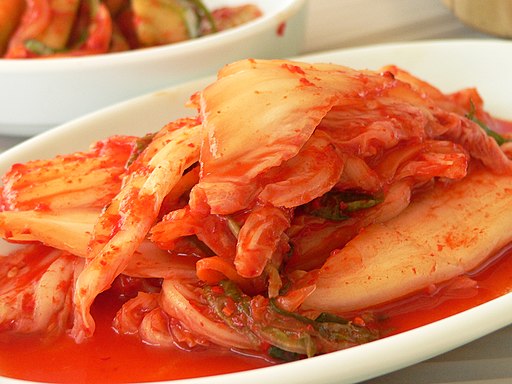Recipe Sunday 2024-03-17
We feel, and studies suggest, that cooking can be a form of therapy for many. On Sunday, we post recipes for those looking for new ways to diversify their cookbooks (we do not get paid for this). —Editorial Team.
Cabbage Kimchi

Nagyman, a flickr user, CC BY-SA 2.0, via Wikimedia Commons
Category Side dish recipes
Time 3–6 days
Difficulty Medium
Cookbook | Ingredients | Recipes | Korean Cuisine
Kimchi (김치), also spelled kimchee or gimchi, is a Korean dish of pickled vegetables, usually napa cabbage or Korean radish and is commonly served as a side dish. It is usually fermented in a brine of anchovy sauce, ginger, garlic, green onion, and chilli pepper. There are countless varieties—at least as many as there are households. The following is a standard recipe for baechoo kimchi (napa-cabbage kimchi), a common variety and often the first kind of kimchi that jumps to mind for non-Koreans.
Ingredients
1 head napa cabbage (baechu, Chinese cabbage, wombok)
½ cup sea salt (or any coarse salt)
1 cup water
2 tbsp minced garlic
1 tsp minced ginger
½ cup gochugaru (Korean chili powder)
2 tsp salt
1 tbsp sugar
¼ cup jeot gal (Korean fish sauce)
½ onion, thinly sliced
¼ carrot, thinly julienned
¼ Korean radish (muwoo), thinly julienned
4 green onions, cut into 3-cm pieces
Procedure
Quarter the napa cabbage, wash, and drain.
Combine coarse sea salt and water.
Put cabbages in salted water and take out one at a time to get salt down.
Add cabbages to a container. Pour salted water over top, and set aside for at least 6–8 hours (overnight is great). The cabbage should be soft enough to bend.
Wash cabbages and drain well.
Combine gochugaru, salt, sugar, jeot gal (Korean fish sauce), minced garlic, and minced ginger.
Mix the onion, carrot, radish, and green onion into the chilli powder mixture.
Take one cabbage, and stuff the above mixture between every layer.
Try to fold the cabbage in half. With 2 outer leaves, wrap the whole thing securely.
Put cabbages in an airtight container, and let it sit at room temperature overnight.
Refrigerate for 2–3 days at minimum. After a few days, you will notice some liquid. This is totally normal and a sign that the kimchi is ripening.
Notes, tips, and variations
Korean radishes are large (about ½ to 1 kilogram). Japanese (daikon) radishes or a larger quantity of small European radishes could substitute.
The brine can be varied to include many other ingredients. Be creative.
The jeot gal can be replaced with moderate amounts of salted tiny shrimp, raw butterfish, or raw oysters. Seafood can also be left out entirely, although an appropriate amount of salt needs to be added in place of missing jeot gal. Alternative flavors can include Asian pears or tangerines.
Source: Wikimedia Commons under Creative Commons License

